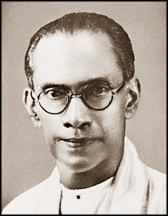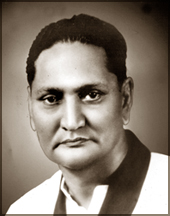The People’s Revolution in 1956
W. Annesley Sumith Fernando
Years ago, on July 12, 1951 to be exact, S. W. R. D. Bandaranaike, a
giant among UNPers, serving as the Minister of Health and Local
Government made a bold decision to forgo all positions and privileges he
held in the party and the Government and to shun all links with UNP.
 |
 |
|
SWRD Bandaranaike |
D. A.
Rajapaksa |
In the August assembly of the Parliament he walked across the floor,
all alone to the opposition ranks, displaying courage and determination.
As he measured his steps he felt a shadow following him. SWRD turned
back. He was startled. A person behind him was measuring his steps in
tandem with him. He had a follower. The follower was none other than D.
A. Rajapaksa, the MP from Beliatta. He had his links to the famous ‘Lion
Clan of Ruhuna’ and was the father of President Mahinda Rajapaksa.
SWRD played a dominant role in establishing SLFP in 1951, D. A.
Rajapaksa’s contribution in this cause was no second to that of SWRD.
Their untiring efforts gave birth to a new political party, which would
become a force to be reckoned within the Sri Lanka political arena.
The UNP of the day appeared to be a party rotten to the core, holding
fast to the manipulative hands of the former colonial masters. It paid
lip service to all what was indigenous. It had nothing meaningful to
offer to improve the lot of local farmers, indigenous physicians and
humble workers. National languages and religions had no place in its
agenda.
UNP appeared to be the darling of the abled and the rich,
industrialists and the planters. Plight of the common man irked not the
conscience of UNP, instead the delight of the rich cut a common chord
with its policies and programs. SWRD could no more align with a party so
degenerated, so aloof from the ordinary masses.
New political party
SWRD presented these proposals to the Cabinet of Ministers after
prolonged thought and much deliberation. He did not want them to be
rushed through in haste. It was not even after the UNP has won the
elections in 1947.
In fact they were presented when DS suggested the idea of forming a
new political party to the then National Union, Tamil Union, Muslim
League, Mahajana Sabhawa and Sinhala Maha Sabhawa, which was headed by
SWRD himself. DS exclaimed, ‘Let’s join as a group and build a single
party.’
Accordingly the UNP was formed a new chapter in the political annals
of the country was opened. DS too agreed with those proposals, which
were approved and accepted at the Sinhala Maha Sabha session in Madampe.
But in no time SWRD understood that it was a ploy, a plot to mislead
him.
SLFP was still in its infancy, but presented a bold proposals to the
other political parties who were united in their opposition to the UNP.
The proposal called for a ‘no-contest’ pact between the SLFP and LSSP,
Communist Party and Revolutionary Sama Samaja Party. It amounted to an
invitation from David the minnow to Goliath the giant.
General election
LSSP which dreamed of forming a Government on its own flatly,
rejected the suggestion, comparing it to an offer made by an ageing
wretched to a pretty damsel.
What was the result; where did it lead to? The old established LSSP
could muster just 9 seats at the general election. But the ‘anti-UNP’
SLFP, unheard and unsung, secured 9 seats. David appeared to had grown
up out of proportions to the chagrin of Goliath.
When SLFP was being formed Matale MP Bernard Aluvihare, Dambulla MP
H. B. Tenne all avowed UNPers joined the SLFP just before the elections
in 1952. Other MPs who were able to preserve their victories achieved in
1952 were C P de Silva of Polonnaruwa, C A S Marikkar of Kadugannawa, S
D Bandaranayake of Gampaha, D. A. Rajapaksa of Beliatta, Henry
Abeywickrema of Baddegama and C. R. Beligammana of Mawanella. Soon after
the general election in 1952, SWRD became the leader of the Opposition.
N. M. Perera, former leader of the Opposition, along with the old
Marxists agreed with this development.
Dudley’s departure paved the way for Kotelawala to the PM’s mantle.
He was iron hearted. He feared neither men nor demons. By 1955, the
people were fed up with the UNP and were craving for a new
administration to take over reigns of the country.
People were hunting for options they weighed the pros and cons
between NM and SWRD, the most outstanding candidates. It was during this
period that ethnic and language related problems cropped up.
The Government of the day followed a strange policy towards this
issue. To the Northerners they said one thing and to the Southerners
they said a totally different thing. LSSP and the Communist Party held
fast to the ideology that Tamil and Sinhala should be given equal
importance and recognition.
SLFP chartered along a different course, stating that Sinhala should
be the official language. SWRD went to the extent of promising to make
Sinhala the official language within 24 hours. UNP did not fall behind,
but made a similar declaration i.e., Sinhala the Official Language at
the historic ‘Kelaniya Sammelanaya’.
Before this event Kotelawala had conferred with JR. Kotelawala was
critical of the UNP’s intended stand on the Official Language. He feared
UNP’s stand would lead to divisions and difference based not only on
language, but caste and creed. JR said, “No way, no alternative other
than this, if we are to win the election.” Kotelawala had to make a
retreat and fall in line with the party stand.
By this time Philip Gunawardena stood stranded. He had neither the
support of the Communist Party nor LSSP, which according to his
assumptions had the potential to win elections. He voiced a different
language strategy to be accounted among those who attracted attention.
His party, the Revolutionary Sama Samaja Party proposed Tamil as a
regional language and Sinhala as the official language. Amidst these
developments SWRD endeavoured to assemble all anti-UNP forces under a
single umbrella. This served as a god-send opportunity to Philip who had
no place to set his foot. Philip joined SWRD. All anti UNP forces and
the leftists rallied round SWRD.
Amidst all these developments a further incident took place in July,
1955. ‘Dinamina’ carried a picture of Sir John feasting on a roasted
calf at the ‘Barbeque’ (‘Barbeque’ has become a common, everyday event
now, but in 1950s it was a privilege reserved for the rich only) was
thrown at his birthday party on a day before Poya Day.
This incident hurt the religious sentiments of the majority and
raised a hue and cry across the country. It became a hot issue, as
strong the language issue during the 1956 election campaign.
The UNP and the way it ran the country irked all people without any
difference. Religious leaders, the workers, Government servants,
employees in the private sector and the ordinary people were frustrated
and were yearning for a way out. Indigenous physicians practising
‘Ayurveda’ received a step-motherly treatment at the hands of the
Government.
Pancha Maha Balavegaya
Equal was the plight of the teachers who taught Sinhala. All these
people drawn from the different segments of the society yearned to
create a country devoid of all racial, religious, status related
differences and deviations. These expectations assembled them under the
common banner of the Great Five Forces i.e., the Pancha Maha Balavegaya,
consisting of the clergy, physicians, teachers, farmers and workers.
People like P. B. Alwis Perera, Sagara Palansuriya and T. B. Tennekoon,
Somaweera Chandrasiri, too joined SWRD.
They were named and famed poets in the country and they represented
the support, emerging from the artists in favour of SWRD.
This development wherein SWRD became the undisputed leader of the
‘Pancha Maha Balavegaya’ sent shock waves through the entire
establishment of the UNP. Sir John was shaken to his very bones. R. G.
Senanayake, the former Minister for Trade came forward to contest not
only Dambadeniya, which was his own fort, but Kelaniya too, which was
JR’s stronghold. JR stood mystified. His election campaign appeared to
be crumbling under the weight of these developments.
SWRD, propelled by the drive and determination of the ‘Pancha Maha
Balavegaya’ plunged himself with full force into the election campaign.
People in their numbers, increasing day by day rallied round MEP and
SWRD was encouraged; he went around the country; addressed rallies,
morning and evening; day and night.
All meetings were well attended by people in their thousands. This
development frightened Sir John and he started to play a new tune. “If I
win 10 seats, I’ll be the Prime Minister” - this was how he addressed
the election meetings.
The election was over and the results were being announced. The
curtain raiser was Matale electorate. Nimal Karunatilake, a stranger to
Matale - Journalist has won the seat for MEP, by an impressive majority
of 2,595 votes. Then came the deluge. Prominent cabinet Ministers turned
out to be losers. Minster of Labour M. C. M. Kaleel, Labour Party Leader
A. E. Gunasinghe, Colombo Mayor V. A. Sugathadasa had lost Colombo
Central seat (Appointed 3 MPs) to M. S. Themis, an ordinary post worker.
Minister of Finance M. D. H. Jayawardane had tasted defeat Horana at the
hand’s of Sagara Palansuriya (KAS), a poet. Minister of Local Government
A. Ratnayake (Wattegama) had been downed by P. B. A. Weerakoon, just a
teacher. In like fashion C. A. S. Marikkar, C. R. Beligammana, Sirimewan
Godage, J. C. W. (JM) Munasinghe, of MEP had overcome the Minister of
Health E. A. Nugawela (Kadugannawa), Minister of Posts N. H. Keertiratne
(Mawanella), Minister of Lands D. P. B. Mahadivulwewa Disawa (Anuradhapura),
Minister of Trade Sherley Corea (Chilaw) respectively. Speaker Sir
Albert F. Peiris lost to Hugh Fernando. Baddegama parliamentarian Henry
Amarasuriya lost to Henry, Abeywickrema of MEP. SWRD won his electorate
with a thumping majority of 41997 votes. Philip Gunawardena came out
with a majority of 22252 votes. Robert Gunawardena of LSSP won Kotte
with majority of 14806 votes. Dr. N. M. Perera, the LSSP leader had
Ruwanwella in his lap with a majority of 6228 votes. R. G. Senanayake
retained his stronghold Dambadeniya with comfortable ease. He outscored
his UNP opponent by 24907 votes and the poor fellow had to forgo his
deposit too.
Cold War
S.W.R.D. Bandaranaike was sworn in as the Prime Minister and his
Cabinet was made up of 14 ministers. April 12, 1956 Phillip Gunawardane,
P. H. William Silva and T. B. Illangaratne all from the MAXIST camp were
appointed as Ministers. Other side like R. G. Senanayake, Stanley Zoysa,
W. Dahanayake, C. P. de Silva, Wimala Wijewardhane, were anti-lefties.
The ‘Cold War’, between the rightist and leftist camps in the Cabinet -
which remained unobserved, burst out into the open as an outright
confrontation in 1959, May. ‘Boralugoda Sinhaya’ - Philip Gunawardane
‘Nishsapda William’ - P. H. William Silva resigned from Ministerial
posts. Had the leftist parties - LSSP and Communist Party - came forward
to support comrade Philip during his struggle the developments would
have been quite different.
The First People’s Revolution in 1956 came to an end on September 26,
1959, after the assassination of ‘Common people’s Prime Minister,
Solomon West Ridgeway Dias Bandaranaike.’ The rest is common knowledge. |



